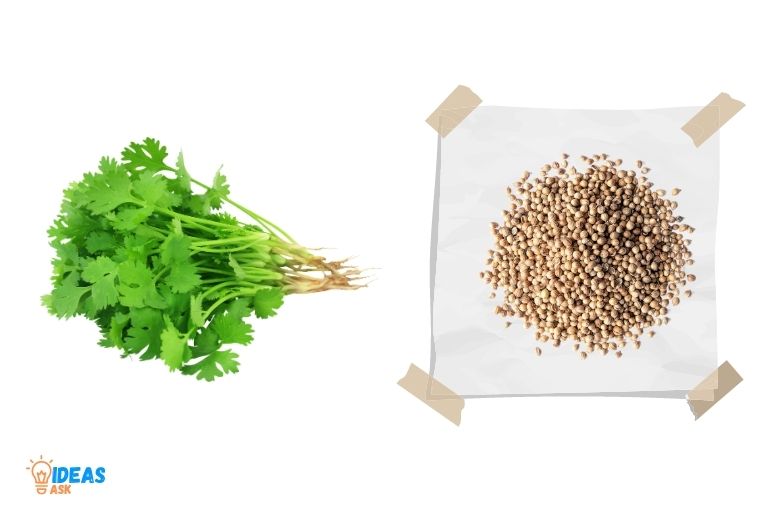How to Germinate Cilantro Seeds Paper Towel? 10 Steps!
To germinate cilantro seeds using the paper towel method, you will need to follow a few simple steps, including preparing the seeds, creating a moist environment, monitoring the germination progress, and transplanting the seedlings to a suitable growing medium.
The paper towel method is an efficient and easy way to germinate seeds, particularly for beginners. It allows you to monitor the progress of the germination process closely and ensures the seeds receive adequate moisture.
Cilantro seeds, also known as coriander seeds, can be germinated using this method to speed up the process and improve the chances of successful seedling growth.
Before starting the germination process, soak the cilantro seeds in water for 12-24 hours to help soften the outer seed coat and enhance germination rates.
After soaking, place the seeds on a damp paper towel and fold the towel over to cover them. Put the folded towel inside a sealed plastic bag or airtight container, ensuring that there is some air trapped inside.
This creates a moist environment for the seeds to germinate. Place the container in a warm place, ideally with a temperature of around 65-75°F (18-24°C). Check the seeds daily to monitor progress, keeping the paper towel moist at all times.
Once the seeds have sprouted small roots and shoots, carefully transplant them to a suitable growing medium
10 Steps to Germinate Cilantro Seeds Using Paper Towel
| Step | Description |
|---|---|
| 1 | Gather materials: cilantro seeds, paper towels, a plastic bag, and water spray bottle. |
| 2 | Moisten a paper towel using the water spray bottle until it is damp but not soaking wet. |
| 3 | Spread the cilantro seeds evenly on the damp paper towel, leaving some space between each seed. |
| 4 | Fold the paper towel to cover the seeds, ensuring they are still spaced out and not stacked on top of each other. |
| 5 | Place the folded paper towel with seeds inside the plastic bag and seal it to create a humid environment. |
| 6 | Label the plastic bag with the date and type of seeds (cilantro). |
| 7 | Place the sealed plastic bag in a warm, dark location, such as a kitchen cupboard or drawer. |
| 8 | Monitor the progress of the seeds daily, making sure to keep the paper towel consistently damp by spraying water if needed. |
| 9 | Wait for the seeds to germinate – this process typically takes 7-10 days for cilantro seeds. |
| 10 | Once the seeds have sprouted, carefully remove them from the paper towel and plant them in a suitable growing medium. |
Key Takeaway

Five Facts About Germinating Cilantro Seeds Using Paper Towel
Preparing The Cilantro Seeds For Germination In Paper Towel
Share Important Information On Sourcing Quality Cilantro Seeds
If you are planning to germinate cilantro seeds in a paper towel, it is essential to start with high-quality seeds.
Here are some tips on how to source quality cilantro seeds:
- Choose seeds from a reputable supplier to ensure that they are fresh and not expired.
- Look for seeds with uniform size and color, which indicates good quality.
- Check the seed packet to confirm if they are suitable for germination and if they are a good fit for your growing conditions.
- Opt for organic seeds to avoid exposure to harmful pesticides.
Explore The Best Techniques For Preparing The Seeds For The Germination Process
Now that you have sourced the best quality cilantro seeds for germination, it is time to prepare them for the process.
Here are some tips on how to prepare cilantro seeds for germination:
- Soak the cilantro seeds in water overnight to help loosen the seed coat and to promote quicker germination.
- Wet a paper towel with water and wring it out to remove any excess water.
- Place the cilantro seeds on the wet paper towel, making sure that they are properly spaced to permit even germination.
- Fold the wet paper towel and put in a plastic bag, leaving some space to allow air flow.
- Store the bag of seeds in a warm place, away from direct sunlight.
Offer Tips On How To Select The Best Paper Towels For The Germination Process
Choosing the right paper towel is crucial in the germination process of cilantro seeds.
Here are some tips on how to select the best paper towel for germination:
- Use unbleached paper towels as bleached paper towels could contain harmful chemicals that could harm the seeds.
- Ensure that the paper towel is absorbent enough to prevent the seeds from sitting in water, which can cause them to rot.
- Opt for a thicker paper towel to ensure it does not tear easily while handling it, as torn paper towels can damage the seeds and impact their germination rate.
- Lastly, ensure that the paper towel is of high quality and suitable for the germination process.
Germinating Cilantro Seeds In Paper Towel
Cilantro, also known as coriander, is a popular herb that adds flavor to many delicious dishes. However, before you can enjoy its zesty taste and unique fragrance, you need to germinate cilantro seeds.
While you can germinate these seeds in soil, a simpler and faster method is to germinate them in a paper towel.
Provide A Step-By-Step Guide On How To Germinate Cilantro Seeds In Paper Towels
- Take a few sheets of paper towels and moisten them with water. Make sure the paper towels are damp and not soaking wet.
- Place the damp paper towels on a plate or tray.
- Spread the cilantro seeds evenly on the damp paper towels, leaving a little space between them.
- Cover the seeds with another layer of damp paper towel, making sure they are in contact with the seeds.
- Place the plate or tray in a warm and bright location, but away from direct sunlight.
- Check the paper towels every day to ensure that they remain moist.
- After a few days, you will see that the seeds have started to sprout. Once they have sprouted, you can plant them in pots or directly in the ground.
Share Any Important Tips That Could Help Make The Germination Process More Successful
- Use fresh cilantro seeds for the best results.
- Do not allow the paper towels to dry out, as this will cause the seeds to die.
- Keep the plate or tray in a warm and bright location to encourage germination.
- Do not overcrowd the seeds to allow them to get enough space and nutrients.
- You can also cover the plate or tray with plastic wrap to create a mini-greenhouse effect and keep the seeds warm and moist.
- Once the seeds have sprouted, make sure to transplant them into soil as soon as possible.
- If you are planting cilantro seeds outdoors, ensure that the temperature is warm enough for successful germination.
Germinating cilantro seeds in paper towels is a simple and effective method to start your herb garden. By following these step-by-step guidelines and tips, you’ll be able to enjoy fresh cilantro all year round.
Transplanting Germinated Cilantro Seeds
Once your cilantro seeds have germinated, it’s time to transplant them to their final growing location. Here are the best techniques for transplanting germinated cilantro seeds:
Timing Is Crucial
Make sure to transplant the seedlings once they have developed a few leaves and are about two inches tall. Waiting too long could stunt the growth and development of the plants.
Soil Conditions
Before you transplant, ensure that the soil is well-draining and rich in nutrients. Add compost or other organic matter if necessary. Cilantro prefers a neutral to slightly alkaline soil ph (around 6. 5 to 7. 5).
Proper Spacing
Transplant the germinated cilantro seedlings at least six inches apart to allow ample room for growth and proper air circulation. If you plan to grow your cilantro in a container, ensure there is enough space to accommodate each seedling.
Watering Tips
Make sure to water your transplanted cilantro regularly, but don’t overwater. Cilantro doesn’t like soggy soil but requires enough moisture to thrive. Avoid watering the leaves and focus on the soil around the roots to prevent stem rot.
Sunlight
Cilantro prefers partial shade to full sun, so ensure they get enough light without direct sunlight. A few hours of morning sun and some shade in the afternoon is ideal.
Fertilizer
Fertilize cilantro with a balanced fertilizer, low in nitrogen, every four weeks once the seedlings are established. Nitrogen-rich fertilizers can lead to excessive leaf growth and weak stems.
Now that you know how to transplant germinated cilantro seeds, you can enjoy fresh, tasty cilantro in your favorite dishes. Happy planting!
Troubleshooting Common Issues During The Germination Process
Highlight Common Issues That People Face During The Germination Process
When trying to germinate cilantro seeds using the paper towel method, you may face some issues that can hinder the germination process. It’s important to be aware of these common issues to set yourself up for success and avoid disappointment.
Here are some common issues you may face:
- Seeds fail to sprout: This can be due to several reasons, including poor seed quality, inadequate water supply, or insufficient temperature.
- Mold growth: Mold can develop on the paper towel if it is too wet and not well-ventilated.
- Roots don’t grow: If the seeds do sprout, but the roots don’t grow, it could be due to insufficient moisture or incorrect temperature.
Share Actionable Strategies For Troubleshooting These Issues Effectively
There are several strategies you can follow to address these issues and ensure successful germination:
- Use high-quality seeds: Be sure to use fresh cilantro seeds, and purchase them from a reputable source to avoid any issues with seed quality.
- Strike the right balance of moisture: Make sure the paper towel is damp, but not saturated with water. Add water as needed to keep the towel moist.
- Ensure proper ventilation: Keep the paper towel out of direct sunlight and in a well-ventilated area to prevent the growth of mold.
- Monitor the temperature: Maintain a temperature of around 70°f to 75°f for optimal germination.
- Use a seed starter mix: If you’re having trouble with the paper towel method, consider using a seed starter mix instead.
Offer Tips On How To Avoid Common Mistakes When Germinating Cilantro Seeds In Paper Towels
To avoid common mistakes during the germination process, here are some tips to follow:
- Don’t oversaturate the paper towel with water. This can drown the seeds and prevent them from germinating.
- Use high-quality seeds that are suited to your area’s climate.
- Monitor the temperature closely and maintain a consistent temperature to ensure optimal germination.
- Check the paper towel regularly and remove any seeds that have developed mold.
- Don’t mix up the orientation of the seeds. Make sure the seeds are all facing the same direction.
By following these strategies and tips, you can successfully germinate cilantro seeds using the paper towel method and enjoy a bountiful harvest of fresh cilantro for your culinary creations.
FAQ About Germinating Cilantro Seeds Using Paper Towel
How Do You Germinate Cilantro Seeds In A Paper Towel?
To germinate cilantro seeds in a paper towel, first fold the seeds in damp paper towels and put them in a warm place. Check daily and mist with water when necessary until the seedlings reach 1-2 inches tall.
What Is The Best Temperature To Germinate Cilantro Seeds?
The ideal temperature for germinating cilantro seeds is between 21-24°c (70-75°f).
How Long Does It Take For Cilantro Seeds To Germinate On A Paper Towel?
Cilantro seeds typically take 7-10 days to germinate on a paper towel.
Can You Transplant Cilantro Seedlings When They Germinate On A Paper Towel?
Yes, once the cilantro seedlings are about 1-2 inches tall, they can be transplanted into a container or garden. Make sure the soil is moist and rich in nitrogen.
Conclusion
To sum up, germinating cilantro seeds using a paper towel is a simple and efficient process that can be done with minimal resources. By following the steps outlined in this post, you can boost your chances of successfully germinating your cilantro seeds and growing a lush, healthy crop.
Whether you’re an experienced gardener or just starting out, learning how to germinate cilantro seeds can be a fun and rewarding experience. By taking the time to properly germinate your seeds, you can ensure the best possible start for your plants.
So why not give it a try? You might be surprised by how much you enjoy the process and the delicious cilantro you’ll be able to add to your favorite recipes.






